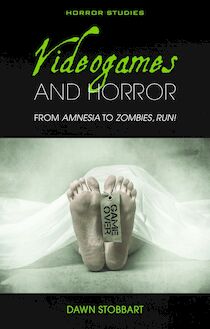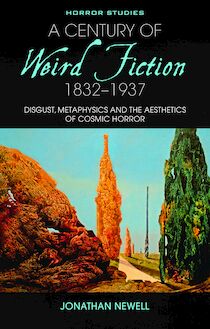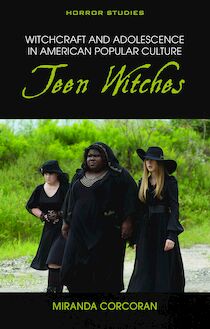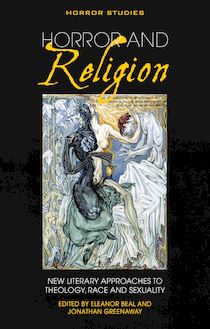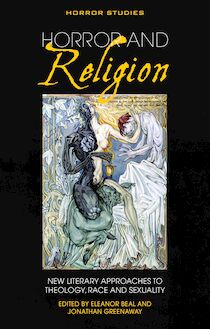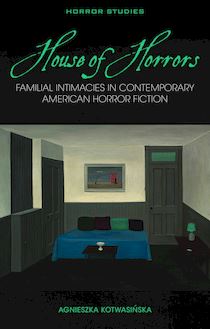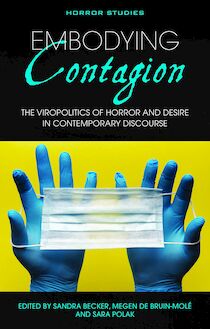-
 Univers
Univers
-
 Ebooks
Ebooks
-
 Livres audio
Livres audio
-
 Presse
Presse
-
 Podcasts
Podcasts
-
 BD
BD
-
 Documents
Documents
-
- Cours
- Révisions
- Ressources pédagogiques
- Sciences de l’éducation
- Manuels scolaires
- Langues
- Travaux de classe
- Annales de BEP
- Etudes supérieures
- Maternelle et primaire
- Fiches de lecture
- Orientation scolaire
- Méthodologie
- Corrigés de devoir
- Annales d’examens et concours
- Annales du bac
- Annales du brevet
- Rapports de stage
La lecture à portée de main
Vous pourrez modifier la taille du texte de cet ouvrage
Découvre YouScribe en t'inscrivant gratuitement
Je m'inscrisWitchcraft and Adolescence in American Popular Culture , livre ebook
Découvre YouScribe en t'inscrivant gratuitement
Je m'inscrisEn savoir plus
Vous pourrez modifier la taille du texte de cet ouvrage
En savoir plus

Description
In the decades since the Second World War, the teenage witch has emerged as a major American cultural trope. Appearing in films, novels, comics and on television, adolescent witches have long reflected shifting societal attitudes towards the teenage demographic. At the same time, teen witches have also served as a means through which adolescent femininity can be conceptualised, interrogated and reimagined. Drawing on a wide theoretical framework – including the works of Deleuze and Foucault as well as recent new materialist philosophies – this book explores how the adolescent witch has evolved over the course of more than seventy years. Moving from the birth of the bobby soxer in the 1940s through to twenty-first-century teenage engagements with fourth-wave feminism, the author discusses a range of themes including embodiment, agency, identity, violence and sexuality.
List of Abbreviations of Frequently Referenced Texts
Introduction
Chapter 1: Towards a Teratology of the Teenage Witch
Chapter 2
‘Bitch Witches’: Marion Starkey and the Birth of the Post-War Teenage Witch
Chapter 3
‘Leave Something Witchy’: Identity Formation and Perverse Readers in the Long 1960s
Chapter 4
Makeover Narratives and Glamourous Transformations: The Postfeminist Teen Witch
Chapter 5
‘How could there not be a choice? Free will?’: Agency and Choice in Teen Witch Texts of the Fourth Wave
Index
Sujets
Informations
| Publié par | University of Wales Press |
| Date de parution | 15 juillet 2022 |
| Nombre de lectures | 0 |
| EAN13 | 9781786838940 |
| Langue | English |
Informations légales : prix de location à la page 0,2850€. Cette information est donnée uniquement à titre indicatif conformément à la législation en vigueur.
Extrait
WITCHCRAFT AND ADOLESCENCE IN AMERICAN POPULAR CULTURE
Teen Witches
HORROR STUDIES
Series Editor
Xavier Aldana Reyes, Manchester Metropolitan University
Editorial Board
Stacey Abbott, Roehampton University
Linnie Blake, Manchester Metropolitan University
Harry M. Benshoff, University of North Texas
Fred Botting, Kingston University
Steven Bruhm, Western University
Steffen Hantke, Sogang University
Joan Hawkins, Indiana University
Alexandra Heller-Nicholas, Deakin University
Agnieszka Soltysik Monnet, University of Lausanne
Bernice M. Murphy, Trinity College Dublin
Johnny Walker, Northumbria University
Maisha Wester, Indiana University Bloomington
Preface
Horror Studies is the first book series exclusively dedicated to the study of the genre in its various manifestations – from fiction to cinema and television, magazines to comics, and extending to other forms of narrative texts such as video games and music. Horror Studies aims to raise the profile of Horror and to further its academic institutionalisation by providing a publishing home for cutting-edge research. As an exciting new venture within the established Cultural Studies and Literary Criticism programme, Horror Studies will expand the field in innovative and student-friendly ways.
WITCHCRAFT AND ADOLESCENCE IN AMERICAN POPULAR CULTURE
Teen Witches
MIRANDA CORCORAN
© Miranda Corcoran, 2022
All rights reserved. No part of this book may be reproduced in any material form (including photocopying or storing it in any medium by electronic means and whether or not transiently or incidentally to some other use of this publication) without the written permission of the copyright owner except in accordance with the provisions of the Copyright, Designs and Patents Act. Applications for the copyright owner’s written permission to reproduce any part of this publication should be addressed to the University of Wales Press, University Registry, King Edward VII Avenue, Cardiff, CF10 3NS.
www.uwp.co.uk
British Library Cataloguing-in-Publication Data
A catalogue record for this book is available from the British Library.
ISBN 978-1-78683-892-6
eISBN 978-1-78683-894-0
The right of Miranda Corcoran to be identified as author of this work has been asserted in accordance with sections 77 and 79 of the Copyright, Designs and Patents Act 1988.
The publisher has no responsibility for the persistence or accuracy of URLs for any external or third-party internet websites referred to in this book, and does not guarantee that any content on such websites is, or will remain, accurate or appropriate.
Contents
Acknowledgements
List of Abbreviations
Introduction
1. Towards a Teratology of the Teenage Witch
2. ‘A Pack of “Bobby-Soxers”’
Marion L. Starkey and the Birth of the Post-War Teenage Witch
3. ‘A guide to life’
Identity Formation and Perverse Readers in the Long 1960s
4. Becoming-Witch
Makeover Narratives and Glamorous Transformations
5. ‘How could there not be a choice?’
Agency and Power in Fourth-Wave Teen Witch Texts
Conclusion
‘By then I might be an entirely different person’
Endnotes
Select Bibliography
Acknowledgements
T HIS BOOK is the product of three-years’ worth of research and writing, but it is also the product of a lifelong interest in witches, horror and the Gothic. I owe an immense debt of gratitude to my mother, Mary Corcoran, who happily indulged her strange daughter with weekend trips to the library and the video store. I am so thankful for her support, guidance and understanding. She has always been there for me, even though the academic world I presently inhabit is a million miles from where we started.
I also want to express my deep, heartfelt thanks to my partner Andrea Di Carlo for his endless love and support. Ti voglio bene. I am also lucky to have had the support of wonderful friends. I am immensely grateful to Cara O’Callaghan, Brian Farran, Laura Quirke, Erik Grayson, Edel Semple and Evelyn Hurley for their kindness and ability to distract me from the rigours of research. Equally, I am so fortunate to have had a number of academic collaborators who have also become dear friends: Steve Gronert Ellerhoff, Jeffrey Kahan, Miniature Malekpour and Anne Mahler. I would also like to thank everyone involved with the New Ray Bradbury Review and The Irish Journal of Gothic and Horror Studies for creating two intellectually enriching, yet always welcoming, communities. I am supremely thankful to Kat Ellinger and everyone at Diabolique magazine, not only for publishing my work, but for being an all-round group of wonderful people.
I am incredibly lucky to have worked for the past number of years with kind and compassionate colleagues in the Department of English, University College Cork. Their support and understanding have been endless and unfailing. Thank you as well to my students (past and present, undergraduate and postgraduate): you are always so inspiring.
Lastly, I would like to thank everyone who helped and guided me as I worked on this book. I am enormously grateful to the anonymous reviewer whose insightful feedback and constructive criticism shaped the present monograph into its final form. A huge thank you to University of Wales Press (UWP) Head of Commissioning Sarah Lewis for her patience and kindness. I am likewise indebted to everyone involved with the UWP Horror Studies series for giving my first monograph a home. Thank you to Peg Aloi for sending me copies of her previously published work. I would also like to express my boundless appreciation to Steve Gronert Ellerhoff, Jeffrey Kahan and Andrea Di Carlo for reading drafts of this book, whether in whole or in part.
List of Abbreviations
‘AW’ Ray Bradbury, ‘The April Witch’, in From the Dust Returned (London: Earthlight, Simon & Schuster, 2001), pp. 21–35.
Ca Stephen King, Carrie (London: Hodder & Stoughton, 1974), Kindle edition.
CAS Roberto Aguirre-Sacasa and Robert Hack, The Chilling Adventures of Sabrina (vol. 1) (New York: Archie Comics, 2016).
Cr Arthur Miller, The Crucible (London: Penguin, [1953] 2000), Kindle edition.
CW Afia Atakora, Conjure Women (London: 4th Estate, 2020).
DM Marion L. Starkey, The Devil in Massachusetts: A Modern Inquiry into the Salem Witch Trials (New York: Anchor Books, [1949] 1989).
LOC Michael Thomas Ford, Love and Other Curses (New York: HarperTeen, 2019).
‘SD’ Ray Bradbury, ‘The Sleeper and Her Dreams’, in From the Dust Returned (London: Earthlight, Simon & Schuster, 2001), pp. 17–19.
STW The Complete Sabrina the Teenage Witch: 1962–1972 (New York: Archie Comics, 2017), Kindle edition.
‘TT’ Ray Bradbury, ‘The Traveler’, in From the Dust Returned (London: Earthlight, Simon & Schuster, 2001), pp. 159–71.
WBP Elizabeth George Speare, The Witch of Blackbird Pond (New York: Houghton Mifflin Harcourt, [1958] 2011).
WHALC Shirley Jackson, We Have Always Lived in the Castle (London: Penguin Classics, [1962] 2009).
‘WO’ Ray Bradbury, ‘West of October’, in From the Dust Returned (London: Earthlight, Simon & Schuster, 2001), pp. 69–86.
Introduction
Season of the Witch: The Teenage Witch as Cultural Trope
I N LATE JANUARY 1941, Life magazine published a photo-essay describing a new American phenomenon. Enraptured by the dynamism of his subjects, yet also somewhat tentative about their cliquish intensity, the author of the piece approached his objects of study in a quasi-anthropological manner, categorising them carefully and taxonomically as though he were observing a remote tribe or a strange new species of fauna. ‘This is the season of the subdebutante’, he warns:
These are the days when in shrill perfumed coveys they flutter through the houses and clubhouses of America’s big cities. When summer comes they will disperse to the lakes, beaches and mountains. But now the subdebutante is dynamic, gregarious and at the peak of her plumage. 1
The curious, unwieldly term ‘subdebutante’ describes ‘any socially uninitiated but acceptable maiden of 15 to 18 who gallivants around town with the right young people’. 2 The subdebutante is therefore a sort of proto-teenager, a youth whose voracious consumption, kinetic momentum and cultish devotion to their social circle marks them off as a distinct social demographic. While the use of ‘the word “teenager” to describe the category of young people from fourteen to eighteen’ would not become widespread amongst the American public until around 1944, 3 the subdebutante prefigured many of the concerns that would later accrue around the figure of the teenager: the ‘subdeb’ was superficial, frivolous and self-centred. Like the teenager who would continue her legacy, the subdebutante was constructed in dehumanising terms. In the pages of Life , she is portrayed as an exotic animal, a bird with brilliant feathers at the ‘peak of her plumage’. Despite her affinity for the tokens and trinkets of consumerism, the subdebutante is repeatedly aligned with the natural, animal world. In a section describing ‘slam books’, a diary where teens express their ‘frankest’ thoughts about their social circle, it is explained that these books are ‘circulated privately for feline amusement’. 4 Here, Life magazine invokes a powerful iconography of female adolescence as shallow, animalistic and precociously sexual.
At the same time, there is something inherently supernatural in Life ’s description of these girls: they flutter through houses in the winter season, before dispersing to lakes, beaches and mountains in the summertime. The movements of these young women, their swift flight through homes and their eventual mass migration to the natural spaces of seashores and hilltops echoes the frenzy of early modern witches alighting to their sabbaths deep within the woods or high atop the Brocken. The season of the subdebutante could just as easily be the season of the witch! Their hastening collective flock recalls the descriptions of witches’ sabbaths offered
-
 Univers
Univers
-
 Ebooks
Ebooks
-
 Livres audio
Livres audio
-
 Presse
Presse
-
 Podcasts
Podcasts
-
 BD
BD
-
 Documents
Documents
-
Jeunesse
-
Littérature
-
Ressources professionnelles
-
Santé et bien-être
-
Savoirs
-
Education
-
Loisirs et hobbies
-
Art, musique et cinéma
-
Actualité et débat de société
-
Jeunesse
-
Littérature
-
Ressources professionnelles
-
Santé et bien-être
-
Savoirs
-
Education
-
Loisirs et hobbies
-
Art, musique et cinéma
-
Actualité et débat de société
-
Actualités
-
Lifestyle
-
Presse jeunesse
-
Presse professionnelle
-
Pratique
-
Presse sportive
-
Presse internationale
-
Culture & Médias
-
Action et Aventures
-
Science-fiction et Fantasy
-
Société
-
Jeunesse
-
Littérature
-
Ressources professionnelles
-
Santé et bien-être
-
Savoirs
-
Education
-
Loisirs et hobbies
-
Art, musique et cinéma
-
Actualité et débat de société
- Cours
- Révisions
- Ressources pédagogiques
- Sciences de l’éducation
- Manuels scolaires
- Langues
- Travaux de classe
- Annales de BEP
- Etudes supérieures
- Maternelle et primaire
- Fiches de lecture
- Orientation scolaire
- Méthodologie
- Corrigés de devoir
- Annales d’examens et concours
- Annales du bac
- Annales du brevet
- Rapports de stage
